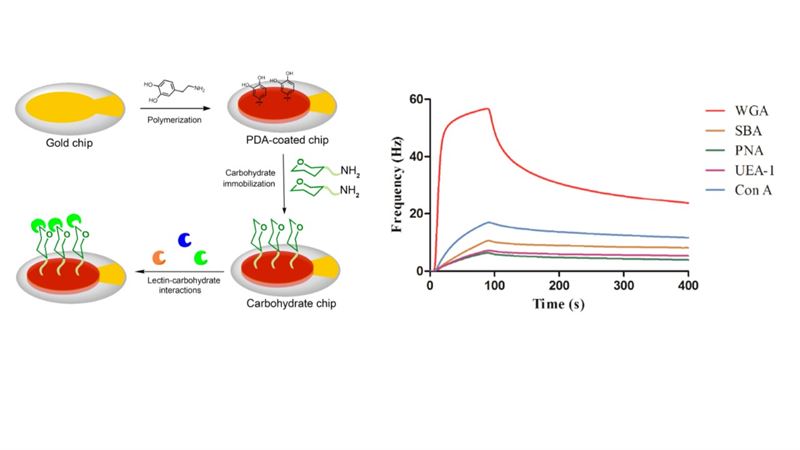Functionalized carbohydrate surfaces - new publication using Attana’s QCM-technolog

Prof Pei and co-workers at the Northwest A&F University has used Attana’s QCM technology when developing a new carbohydrate functionalized biosensor surface. This concept can be used for the detailed understanding of biomolecules interaction with human carbohydrates and combined with Attana’s cell and bacteria based assays, this form an powerful tool in the development of new pharmaceuticals or antibiotics.
In a recent article the functionalization method and characterization of the surfaces are presented. The carbohydrate functionalization is based on polydopamine (PDA) surfaces. The resulting carbohydrate-sensor chips were evaluated in the Attana Cell™ 200 system for real-time characterization of lectin–carbohydrate interactions. Several lectins, including wheat germ agglutinin (WGA), concanavalin A (Con A), Ulex europaeus agglutinin I (UEA-I), soybean agglutinin (SBA), and peanut agglutinin (PNA), were evaluated with respect to interaction characteristics to different carbohydrate chips.
This work follows within Attanas application areas of providing world leading characterization of molecular interactions for drug development. In particular the importance of carbohydrate interactions has been elucidated by several groups using the Attanas QCM-technology. In a recent publication from the group of Prof Solis, the carbohydrate profile of different bacteria were characterized, important knowledge for the development of antibiotics. Previously Prof Salanti and co-workers at Copenhagen University identified a carbohydrate like molecules as a generic cancer target and found that a malaria protein targeting that molecule could be used to cure cancer in animals and Dr Dwek at University of Westminster demonstrated that carbohydrates in the cell membrane affects the accessibility of the HER2 receptor and hence the effect of HER2 targeting antibodies. The current publication from Prof Pei demonstrated a strong complement to the cell-based assays in that sense that cells and bacteria surface contains many different carbohydrates and the possibility to study both the complex and pure interaction of therapeutic molecules with carbohydrates is very powerful.
For more information, please contact:
Teodor Aastrup, CEO Attana AB
e-mail: teodor.aastrup@attana.com
tel: + 46 8 674 57 00
The Board of directors for Attana consider that the information in this press release is not likely to have a significant effect on the share prices, but is of general interest for the shareholders and hence should be communicated.
Attana was founded in 2002 with the vision of in-vitro characterization of molecular interactions mimicking in-vivo conditions. Since then, Attana has developed proprietary label free biosensors for biochemical, crude, sera, and cell-based assays. Attana’s products and research services are used by Big Pharma, biotech companies and academic institutions within the life sciences. To learn more about Attana’s contract research services and our label free cell-based biosensors, please visit www.attana.com or contact sales@attana.com.
Tags:


